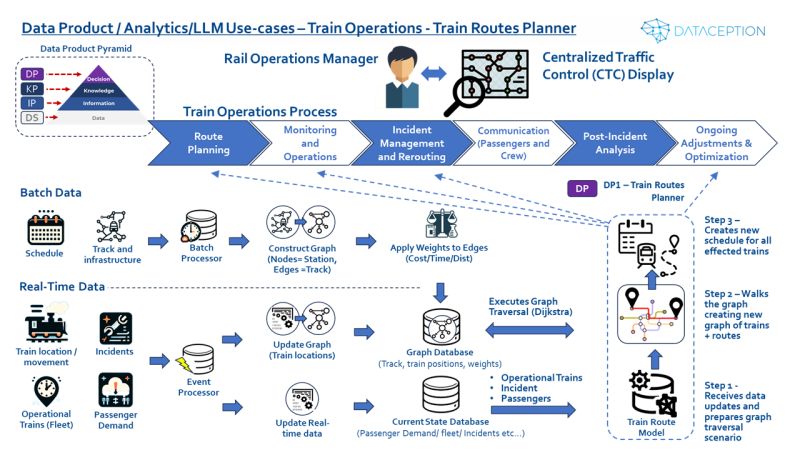Efficient train rerouting is crucial in maintaining smooth operations within a railway network, especially when unforeseen incidents like train breakdowns or crew supply issues occur. This post explores how graph-based analytics and a variation of Dijkstra's algorithm can optimize train rerouting, based on an enhanced real-world use case from our work.
The Challenge
Train scheduling and rerouting is a complex process, demanding real-time decision-making to minimize delays and maintain service quality. Traditional methods often struggle to adapt quickly to disruptions, leading to inefficiencies and passenger dissatisfaction.
The Solution: Train Routes Planner
The Train Routes Planner is a decision product (DP) in our Data Product Pyramid taxonomy. It uses graph databases and advanced algorithms to optimize train rerouting dynamically. Here’s how it works:
Train Operations Process
Route Planning
- Initial Schedule Setting: The Train Routes Planner takes infrastructure data periodically and builds a graph representation in a Graph DB of the network. Stations and junctions are vertices, track segments are edges, and weights on each edge correspond to routing decisions (e.g., cost, time, distance).
- Data Integration: It also integrates schedules, master data (trains, staff), and passenger demand into the train state database.
Monitoring and Operations
- Real-Time Data Ingestion: The planner receives live data on train movements, passenger flows, incidents, and fleet information, updating the train state database continuously.
Incident Management and Rerouting
- Detection and Response: When an incident occurs, such as a train breakdown, the planner triggers the Train Route Model to calculate new routes.
- Algorithm Application: A variation of Dijkstra's algorithm is used to find the shortest, fastest, or cheapest paths from current train positions to their destinations, avoiding affected areas and considering factors like distance, travel time, and track capacity.
Communication
- Updates: Changes are communicated to passengers, crew, and train operations in real time to ensure everyone is informed and can adjust accordingly.
Post-Incident Analysis
- Review and Recommendations: The system analyzes the cause of incidents and the effectiveness of responses, providing recommendations for future improvements.
Ongoing Adjustments & Optimization
- Continuous Improvement: Data from operations is used to refine scheduling and incident response strategies continuously.
Technical Insights
Dijkstra's Algorithm: The core of the rerouting process is a variation of Dijkstra's algorithm, which efficiently finds the shortest paths in a graph. This algorithm is well-suited for the weighted graphs representing train networks. It prioritizes the shortest known path from the source to each node, iteratively improving paths until the optimal route is found.
Graph Database: Using a graph database allows for efficient representation and querying of the complex relationships and constraints within a railway network. This enables the Train Routes Planner to quickly adapt to changes and compute new routes.
Lessons Learned
From our experience, the models used in the Train Routes Planner provided much more consistent results compared to human-based methods, although not necessarily more accurate. Consistency in the models led to more predictable operations and better resource allocation.
Clarifying Terminology
It's important to distinguish between data products and AI products. In our taxonomy:
- Data Products: Focus on the packaging, delivery, and management of data.
- AI Products: Use advanced analytics and data to deliver specific business or operational outcomes.
Ensuring Accuracy and Reliability
To ensure the accuracy and reliability of the Train Routes Planner, several strategies were implemented:
- Robust Data Sources: Leveraging comprehensive data on train schedules, infrastructure, and real-time operations.
- Transparent Algorithms: Using algorithms that are easy to interpret and adjust, ensuring transparency in decision-making.
- Domain Expertise: Incorporating insights from railway operations experts to validate and refine the model.
Project Timeline
The initial version of the Train Routes Planner took several months to design and build. Continuous updates and improvements have since been made, incorporating the latest advancements in LLMs and graph analytics.
Conclusion
The Train Routes Planner exemplifies how graph analytics and advanced algorithms can revolutionize train rerouting processes, enhancing efficiency and reliability.
Call to Action
For more insights and detailed discussions on AI and data product integration or for more real-world examples of data products and AI integration, reach out to us at Dataception Ltd.


